
The Army has many characteristics of a business--if its budget were revenue it would be in the Fortune Top 20--but the leader of the land force’s Office of Business Transformation said he doesn’t think the Army is a business. "I think after due consideration, in the end, the answer to that question must be no,” said Lt. Gen. Thomas Spoehr, in remarks delivered May 28 during the Association of the United States Army's Institute of Land Warfare breakfast.."The Army's sacred…













